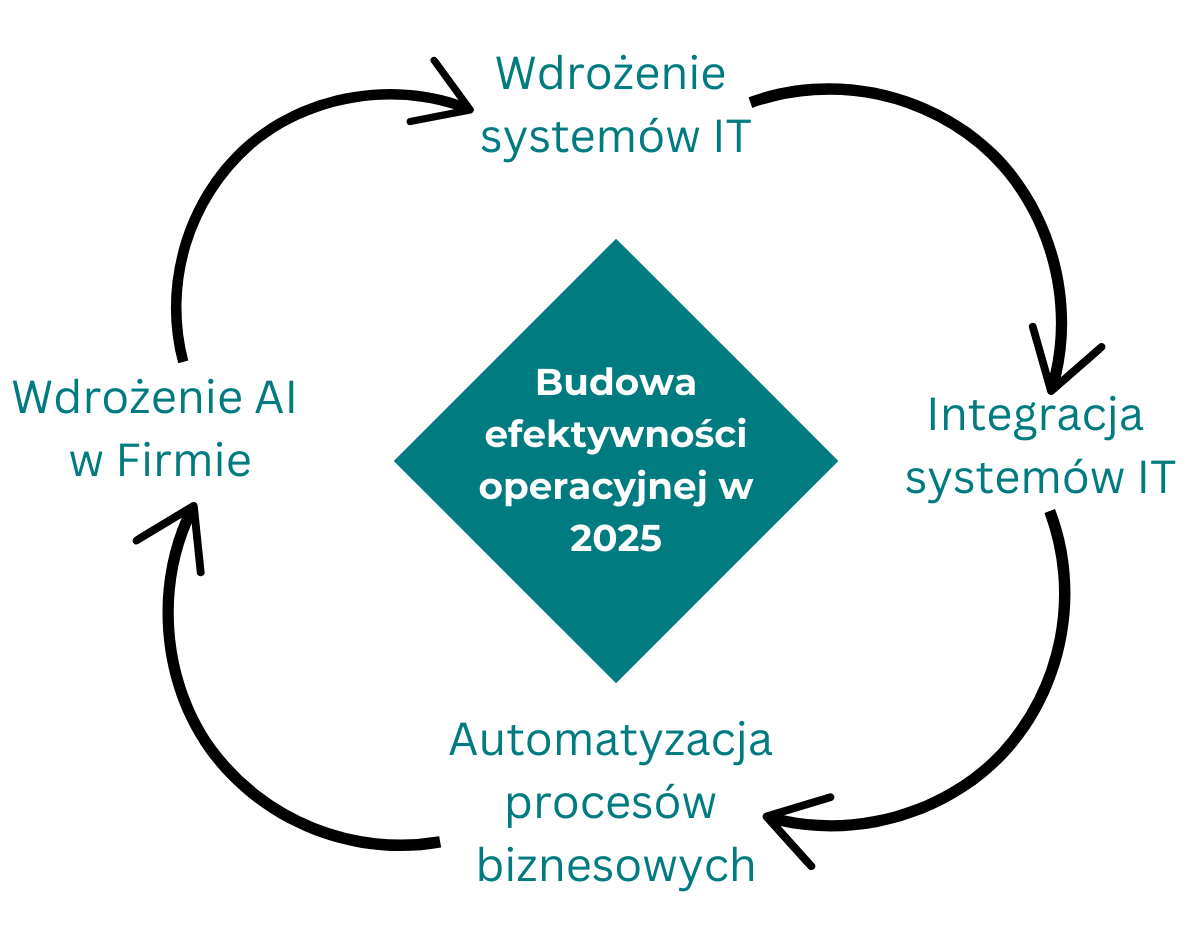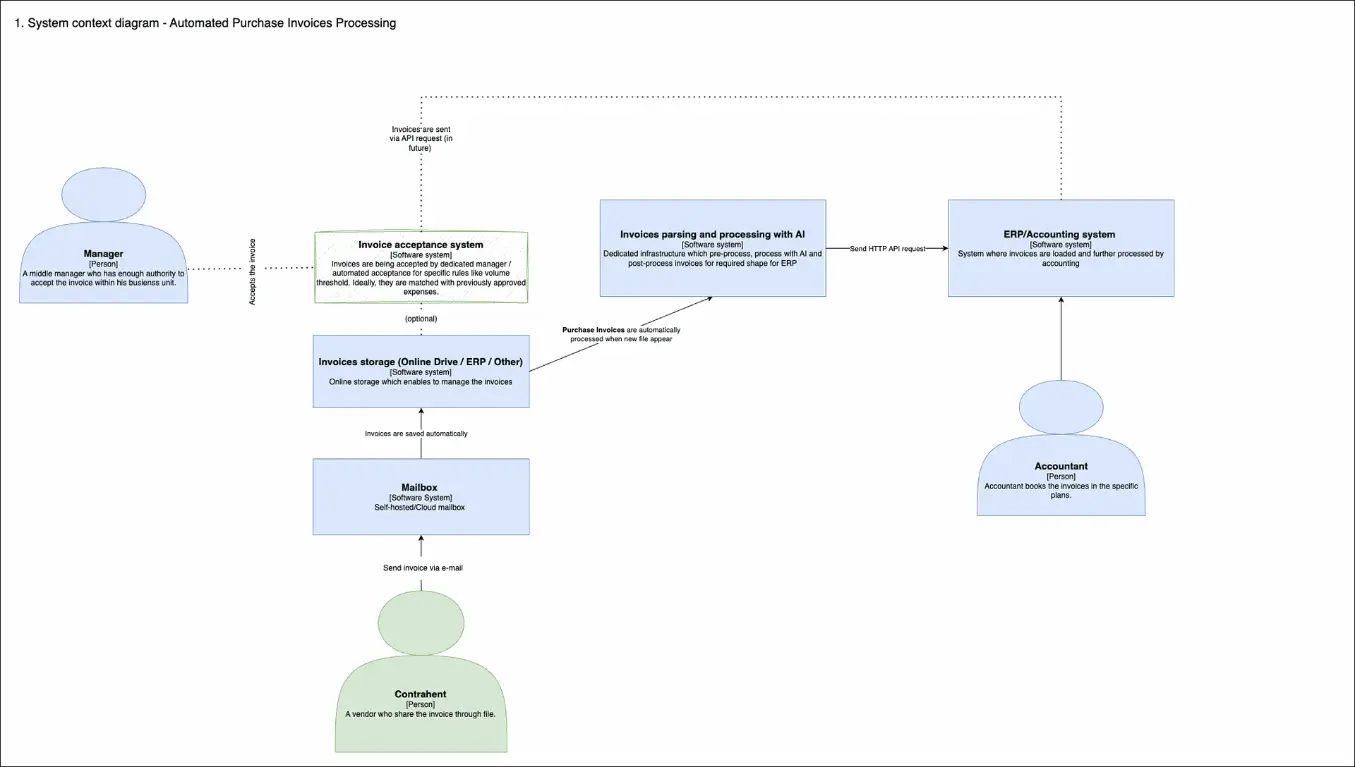Between November 2024 and March 2025, as part of AutomAIze’s development, we conducted a series of workshops focused on identifying potential time and cost savings in internal business processes. We also interviewed nearly one hundred entrepreneurs and executives. The primary sectors we worked with included B2B service companies, manufacturing, e-commerce, pharma, and product/SaaS-based businesses. This article summarizes the challenges observed during those workshops and highlights the growing need for operational efficiency in Polish SMEs through a culture of business process automation, IT system implementation, and integration with AI technologies.
What’s Killing Operational Efficiency in Polish SMEs?
Top operational challenges, as reported by entrepreneurs and executives—especially in Pomerania and Warsaw—are summarized below:
Top operational challenges in polish SMBs
1. Limited Internal IT Capabilities
Companies that are not “digital-first” often rely on a single person responsible for infrastructure or software licenses. This limits proactive innovation and creates long-term technological debt. According to the June 2024 PFR report only 21% of Polish companies report a high level of digital maturity, which correlates with the number of IT personnel available to support IT systems
2. Manual Work in Digital Processes
A major obstacle to operational efficiency is the manual handling of digital workflows. Many processes depend on individuals working with spreadsheets and Word documents—copying and pasting values or managing files manually or across disconnected systems. This approach reduces employee productivity, increases error rates, and creates chaos in day-to-day operations. (read morehere). These issues are also highlighted in digitalization reportsparticularly regarding the adoption of electronic document management. from Webcon orCRN report.
3. Lack of Performance Evaluation for Employees
Many companies lack structured performance review systems, development plans, or clearly defined roles. This undermines team engagement and retention—and as we know, a strong team is the backbone of any efficient operation. unfairly. According to a Zielona Linia report - over half of employees rate their managers poorly when it comes to performance evaluation, and 70% feel their performance is judged
4. Incomplete or Missing CRM Systems
A properly implemented CRM system is fundamental to the digital transformation of B2B sales operations. In an era of information overload, managing relationships through phone and email alone is no longer sufficient. A reliable system to organize client communication is central to driving growth and operational efficiency.According to Eurostat , only 28.5% of companies in Poland use a CRM system—corroborating our own findings
Do you have similiar challenges? Book free consultation here
5. Limited Access to Performance Reporting
Many SMEs rely on basic reporting available in their existing systems or spreadsheets. However, they often lack visibility into key metrics such as profitability, payroll, expenses, and sales pipeline. This intuitive, rather than data-driven, approach hinders decision-making and the prioritization of strategic investments. Only 8.5% of Polish firms analyze "big data" and just 10.5% use BI tools—demonstrating a market-wide trend consistent with our workshop findings.
Poor Information Flow and Lack of System Integration Due to the wide variety of IT systems used—CRM, ERP, ATS, DMS, QMS, communication tools, project management apps, spreadsheets, emails, and websites—many companies fail to integrate them. As a result, data is transferred manually or semi-manually between platforms. This leads to additional administrative workload and increases the risk of human error. This inefficiency significantly affects scalability and service quality in Polish SMEsaccording to Sykom and Oex.
What Investments Are Polish SMEs Planning to Boost Operational Efficiency Through Digital Transformation?
The Role of AI, Business Process Automation, and IT Systems in Driving Operational Efficiency in B2B Companies in 2025
Between 2024 and 2026, many Polish SMEs are preparing to make significant investments in technologies that improve operational efficiency, enable business process automation, and support the implementation and integration of IT systems. Below are the main investment areas driving digital transformation B2B:
Artificial Intelligence (AI)
- Artificial Intelligence and Machine Learning are gaining momentum: 61% of SMEs are implementing AI, and 45% are already using ML tools to boost operational efficiency and business innovation (Polcom). According to IDC, the average ROI from AI adoption is estimated at 270% within 13 months.
Read case study about AI adoption in APC Instytut
Business Process Automation
- Automation platforms such as Google Workspace and Microsoft Power Platform simplify business process automation, including data and marketing management. Forrester reports a 224% ROI on Power Platform (based on NPV), with task completion time reduced by up to 25%.
Read more about BPA for quality reporting automation here
IT Systems Integration
- Management systems: Many companies are planning to implement ERP or CRM systems, which significantly facilitate IT systems integration and streamline business process management (source: ITWiz). According to Salesforce, CRM implementation can deliver an estimated ROI of 314%, while ERP systems yield around 56% ROI (source: Johnygrow).
- Operational and financial reporting: Implementing modern business intelligence tools such as Power BI or Microsoft Fabric can result in approximately 360% ROI over three years, by accelerating and simplifying the information flow across the organization—leading to improved operational efficiency
IT Systems Implementation
- Digitalization grants: Programs such as Ścieżka SMART and Dig.IT offer financial support for SMEs to implement IT systems, including business process automation and cybersecurity enhancements (sources: Comarch, Symfonia).
- Future technologies: The adoption of AI, IoT, and Big Data is essential for increasing competitiveness and driving innovation within organizations (Symfonia, Polcom).
Read case study for automation reporting for operational efficiency in banking
These investments are backed by available grants and funding opportunities, allowing SMEs to modernize their infrastructure and significantly boost their operational efficiency. In the next section, we’ll explore how each of these areas contributes to building a high-performing, future-ready organization.
What is the Role of Business Process Automation in Operational Efficiency?
When Should You Use Business Process Automation — and When to Consider System Integration Instead?
What is the Role of Business Process Automation in Operational Efficiency?
Business process automation (BPA) is a strategic, technology-driven approach to streamlining and optimizing business operations. Its core aim is to increase operational efficiency, reduce errors, and improve productivity—aligned with ISO-9001 quality standards. In practice, BPA uses IT tools to carry out tasks consistently and repeatably, ensuring compliance and continuous improvement.
Its role is critical in delivering full-scale operational efficiency. While systems like CRM or ERP play vital roles, each has limitations. Once these systems are properly integrated, automation can enhance employee performance and drive cost savings across departments.

However, BPA is often misinterpreted or oversimplified. Many assume it simply means building low-code or no-code apps to automate tasks. This can lead to creating solutions where IT systems implementation or proper integration would be more appropriate. In some cases, businesses attempt to apply AI to problems that are algorithmic in nature—where BPA would be a more logical choice. Here are examples of ineffective approaches to automation seen in B2B service companies:
- Developing a custom workflow or low-code app to manage client relationships, even though top-tier CRM systems (e.g. Hubspot for up to 4 users) are available for free.
- Building standalone AI chatbots for customer support instead of using established tools like Live Chat, Intercom, or SmartsUpp that already integrate these capabilities.
- Creating in-house tools for HR processes like performance evaluation or role definitions when robust market solutions exist (e.g., Peopleforce, TalentGuard, or Comarch HRM).
- Designing Excel-based compensation calculators despite having a fully functional ERP system that already includes payroll features.
- Using manual spreadsheets to forecast contract values instead of implementing a proper CRM system that can automatically project deal pipelines based on probability scoring.
Assess if you need business processes automation with free consultation
Now that we’ve covered the broader context of business process automation and its challenges, let’s explore the role of IT systems integration—and how it differs from automation. While both aim to improve operational efficiency, their goals, scope, and impact differ significantly.
Understanding the Difference: IT Systems Integration vs Business Process Automation
Goal, scope, real-world examples
IT systems integrationefers to connecting various digital systems—such as ERP, CRM, HR, and accounting—into a unified ecosystem that enables data sharing and seamless collaboration. It helps reduce manual work and ensures that all systems share accurate and synchronized data about customers, orders, and employees.
Read about IT systems integration scenarios here
Here’s a comparison from the perspective of B2B service companies:
Criteria | IT Systems Integration | Business Process Automation |
Goal | Ensure data consistency and flow across systems | Eliminate manual steps and optimize work |
Scope | Connect various applications and databases | Automate specific processes (e.g., invoicing, reporting, customer service) |
Impact | Improves data accuracy, eliminates duplication | Reduces time, errors, and operational costs |
Example | ERP-CRM integration to avoid manual syncing of client data | Automating finance reports or customer request handling via chatbots |
Well-implemented IT systems integration enhances operational efficiency by streamlining processes—like sending a customer order straight into execution—reducing overhead from redundant systems and improving decision-making through centralized access to real-time data.
Read here more about IT systems integration
Having already understood the differences between IT system integration and business process automation - let's move on to the role of AI in the entire puzzle of operational efficiency.
The Role of AI in Operational Efficiency for SMEs—Especially in B2B Services
AI adoption
Expected budgets
SMEs needs
Expectations vs reality
How does AI support operational efficiency in Polish SMEs? The reality is mixed.
While AI, particularly Generative AI, has massive potential for productivity gains (which directly boosts efficiency), adoption in Poland remains cautious. According to PAP, most SMEs are focused on simple automations rather than advanced AI tools. A study by Mizzox found that 80% of companies prioritize document automation. KPMG reports that 28% of Polish firms deployed AI in 2024 (EY estimates 40%), with another 30% planning to do so. SW Research estimates that Polish SMEs will invest up to 20,000 PLN in AI in 2025—only enough for 20 annual ChatGPT Plus licenses.
Click here to get AI adoption framework
On the flip side, Poland’s AI market is projected to grow by 28% annually until 2030, reaching an estimated $1.8 billion USD by 2025 (Statista).
So, what does this mean for AI’s role in digital transformation B2B?
- Budget constraints – a 20,000 PLN budget only covers minimal AI licenses or ~117 hours of an experienced AI engineer (read morehere).
- Lack of skilled employees – 52% of firms cite workforce limitations as a reason for not adopting AI (IDC).
- Governance and data security concerns – 41% of global firms highlight these as major blockers (IDC).
The AI ecosystem is saturated with hundreds of tools launched daily (e.g., via thereisanaiforthat.com), making it hard for companies to choose and scale efficiently..
As a result, many SMEs find themselves overwhelmed and underprepared when it comes to adopting AI effectively. That’s why building operational efficiency should begin with structured system integration and pragmatic business process automation—before diving deep into complex AI initiatives.
In the next section, we’ll show how to start optimizing operations in B2B service SMEs, step-by-step.
How to Start Building Operational Efficiency in Your Company
Challenges → Priorities → Implementation → Monitoring
As we’ve highlighted in our article on iimplementing AI in business, becoming an "AI-driven" organization is the highest maturity level in terms of operational efficiency—but it's not the only effective one. Every company should go through four essential stages: implementing IT systems, integrating IT systems, applying business process automation, and finally leveraging AI. With this full spectrum in place, businesses in 2025 can choose the most suitable path based on their risks and readiness. Here’s how to develop operational efficiency step by step—ideally revisiting this process quarterly:

- Identify Operational Challenges - every company has its pain points, but not every company talks about them openly. Due to busy schedules and overwhelming workloads, operations directors, CFOs, or CEOs often postpone dealing with internal inefficiencies. Don’t wait—just a 90-minute workshop with process or department owners is enough to define your company’s main bottlenecks. A structured session like this provides clarity on where to begin.
Check here example of operational efficiency workshop
- Prioritize and Match to Capabilities - let’s be honest—no business can change everything at once. Prioritization is crucial. Start with the “low-hanging fruit”—those challenges that bring fast and measurable gains, such as implementing a CRM system or automating repetitive manual tasks. Larger projects, like ERP implementation or migration, should be broken into smaller phases (e.g., starting with specific business functions or departments).
- Implement Gradually - once priorities and solutions are clear, decide whether to implement changes internally or with an external partner. A partner brings momentum and experience but some knowledge may not stay within your team. In-house implementation takes longer and requires full dedication from at least one employee. We recommend gradual rollouts: start with a small pilot group (e.g., introducing CRM) or pick one of your three core business models to automate first. For IT systems integration, begin with the most critical workflows (e.g., payroll or business development).
- Monitor Operational Efficiency - tracking results is crucial both short- and long-term. Define KPIs and methods that will allow you to realistically measure the value delivered after each change (e.g., cost savings, time saved, reduced error rates, or improved work quality). A simple and effective approach is to compare time spent on a process before and after changes. For more structured improvement tracking, consider methodologies like Lean or Six Sigma.
What Is the Added Value of Business Process Automation Culture in 2025?
By combining IT systems, their integration, and business process automation, SMEs—especially B2B service companies—can gain significant advantages in operational efficiency.
Who Should Consider Investing in Business Process Automation?
Building a culture of business process automation should be a priority for companies facing operational bottlenecks caused by manual work, disconnected IT systems, or limited access to analytics. Based on market trends and reports, the following types of organizations should especially consider such an investment:
- Small and mid-sized enterprises (SMEs) seeking to optimize operations and reduce costs in admin, finance, or sales.
- B2B service providers (e.g., consulting, accounting, IT), where customer data consistency and smooth back-office workflows are critical.
- BPO companies aiming to standardize services, cut costs, and improve service quality across clients.
- Organizations without core IT systems (like CRM or ERP) still managing documents and workflows manually.
- Firms with a high volume of manual tasks (e.g., customer service, payroll, admin), where automation significantly cuts costs and errors.
- Digital-native companies that have been digital from day one and want to unify and streamline operations further.
- Organizations looking to improve performance management, where the lack of analytics tools hinders team development and engagement.
- Companies planning IT systems integration to eliminate manual data reentry and establish a single source of operational truth.
Summary: Is It Worth Building Operational Efficiency Through Business Process Automation?
Absolutely. Developing operational efficiency through a culture of business process automation is a vital step for any company looking to stay competitive and optimize internal operations. The benefits are both immediate and strategic:
- Reduced operational costs – less time spent on manual tasks leads to lower labor costs and better profitability.
- Error reduction – automating workflows minimizes human errors, especially in accounting, HR, and customer service.
- Better data management – IT systems integration ensures a single source of truth, helping strategic decisions.
- More business agility – automated processes make it easier to adapt quickly to changing market conditions.
- Improved employee and customer satisfaction – less tedious work means more time for value-creating and creative tasks, which boosts employee engagement and customer experience.
- Scalability and growth readiness – companies that adopt automation early are better prepared to grow without dramatically increasing headcount.
As highlighted in this article, investing in a business process automation culture can yield substantial time and cost savings. Organizations that fail to embrace this shift risk falling behind competitors already leveraging these technologies.
To conclude, business process automation is one of the most powerful levers in building sustainable operational efficiency—and strategic implementation can significantly elevate productivity, service quality, and scalability.
Start Optimizing Your Operational Efficiency Today
Want to build a business process automation culture and digitally transform your back-office operations?
Reach out to us — we’ll reply via email within 24 hours.
